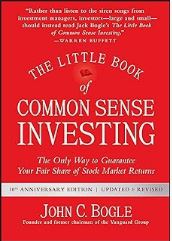 Click on the book to buy on Amazon
Click on the book to buy on Amazon
"The Little Book of Common Sense Investing" by John C. Bogle
is a concise yet comprehensive guide to the principles of passive
investing, focusing on the benefits of low-cost index funds. Bogle,
the founder of Vanguard Group, advocates for a simple and
straightforward approach to investing that minimizes fees and
maximizes long-term returns for investors. Here's a detailed summary
of the key concepts and chapters:
Introduction: The Parable
Bogle introduces the book with a parable about two friends,
Investor A and Investor B, who have different approaches to
investing. Investor A follows a passive index fund strategy, while
Investor B engages in active trading. The parable sets the stage for
the discussion of passive investing principles.
Part 1: The Relentless Rules of Humble Arithmetic
Chapter 1: The Grand Strategy of Common Sense Investing
Bogle outlines the core principles of common sense investing,
emphasizing the importance of simplicity, low costs, and long-term
discipline. He introduces the concept of the "relentless rules of
humble arithmetic" and explains how they apply to investing.
Chapter 2: Prudence Prevails
In this chapter, Bogle discusses the importance of prudence in
investing and the dangers of speculation and market timing. He
explains how passive investing allows investors to capture the
returns of the market as a whole, rather than trying to beat the
market through active management.
Part 2: The Greatest-Ever Investment
Chapter 3: The Telltale Chart
Bogle presents a chart that illustrates the power of compounding
and the long-term growth potential of the stock market. He
emphasizes the importance of starting to invest early and staying
invested for the long term to take advantage of the benefits of
compounding.
Chapter 4: The Index Fund Solution
In this chapter, Bogle introduces the concept of index funds as a
low-cost, efficient way to invest in the stock market. He discusses
the advantages of index funds over actively managed funds, including
lower fees, reduced turnover, and better long-term performance.
Part 3: Rational Exuberance
Chapter 5: Cast Your Lot with Business
Bogle discusses the fundamental principles of investing in
businesses rather than speculating on stocks. He emphasizes the
importance of focusing on the underlying value of businesses and
their long-term growth prospects, rather than short-term market
fluctuations.
Chapter 6: How Most Investors Turn a Winner's Game into a
Loser's Game
In this chapter, Bogle explores the pitfalls of active investing
and the ways in which investors sabotage their own returns by trying
to beat the market. He discusses the impact of fees, taxes, and
behavioral biases on investment performance and advocates for a
passive, index-based approach.
Part 4: Onward and Upward
Chapter 7: Selecting Long-Term Winners
Bogle discusses the criteria for selecting long-term winning
investments, focusing on factors such as low costs, broad
diversification, and adherence to a disciplined investment strategy.
He emphasizes the importance of consistency and patience in
achieving investment success.
Chapter 8: "When the Good Times No Longer Roll"
In this final chapter, Bogle discusses the importance of
maintaining perspective and discipline during periods of market
volatility and uncertainty. He emphasizes the need to stay focused
on long-term goals and to avoid making impulsive decisions based on
short-term market fluctuations.
Conclusion: "Ours Is a Business of Trust"
Bogle concludes the book by reflecting on the importance of trust
in the investment industry and the responsibility that investment
professionals have to act in the best interests of their clients. He
emphasizes the need for transparency, integrity, and a focus on
long-term value creation in the financial markets.